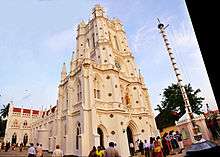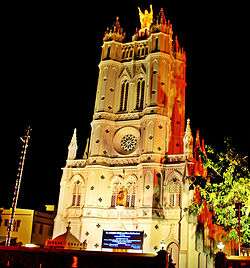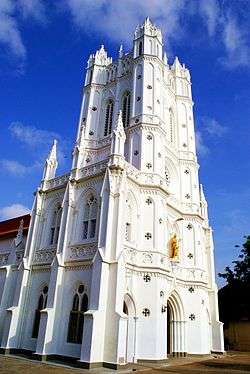Roman Catholic Archdiocese of Trivandrum
| Archdiocese of Thiruvananthapuram Archidioecesis Trivandrensis Latinorum തിരുവനന്തപുരം | |
|---|---|
 St. Joseph's Cathedral | |
| Location | |
| Country | India |
| Ecclesiastical province | Thiruvananthapuram |
| Statistics | |
| Area | 686 km2 (265 sq mi) |
| Population - Total - Catholics |
(as of 2014) 2,368,000 261,220 (11.0%) |
| Information | |
| Rite | Latin Rite or Roman rite |
| Cathedral | St. Joseph's Cathedral, Thiruvananthapuram |
| Patron saint | St Thérèse of Lisieux |
| Current leadership | |
| Pope | Francis |
| Metropolitan Archbishop | Most Rev. Dr. Soosa Pakiam M. |
| Auxiliary Bishops | Most Rev. Dr. Christudas Rajappan |
| Vicar General | Very Rev. Msgr. Eugine H. Pereira |
| Episcopal Vicars | Very Rev. Msgr. Dr. Thomas J. Netto |
| Judicial Vicar | Very Rev. Dr. Gladin Alex |
| Website | |
| Website of the Archdiocese | |


The Roman Catholic Archdiocese of Thiruvananthapuram (Latin: Trivandren(sis) Latinorum) is an archdiocese located in the city of Thiruvananthapuram in Kerala, India.
Population and Area
The Archdiocese of Trivandrum (Thiruvananthapuram) is one of the biggest diocese of Kerala having a Catholic population of nearly 2,50,000 people, even after the bifurcation of the Diocese of Neyyattinkara four years ago. The 75 parishes and 44 Mission stations of the Diocese are grouped together into 8 Vicariates in 3 Episcopates. At present we have 133 incardinated priests in the Archdiocese including those retired, studying and working for other Dioceses and 27 religious priests.[1]
As much as 90 percent of the faithful in our Diocese of Trivandrum hails from the community of fisher folk. This community as a whole is impoverished and is classified by the Government itself as one of the backward communities. In social stratification, fishermen find their place at the lowest rank of the ladder of social setup. "This region is utterly barren and poverty - stricken. Since I came here, I have had no rest. I have been going from village to village. The children would not let me stay at my office or eat or rest till I had taught them some prayer. It was then that I really began to feel that such is the kingdom of heaven. I started to teach them catechism and I saw immediately that they were very intelligent." [2] This is what St. Francis expressed 450 years ago.
Topography
Trivandrum Latin archdiocese is headquartered in Kerala's capital city Thiruvananthapuram, formerly known as Trivandrum. It is situated between north latitudes 8° 17' and 8° 54' and east longitudes 76° 41' and 77° 17'. The archdiocese is bounded by the Arabian Sea on the West and Western Ghat on the East. The wooded highlands on the Western Ghats in the eastern and northeastern borders give Thiruvananthapuram some of the most enchanting picnic spots. A long shoreline, with internationally renowned beaches, historic monuments, backwater stretches and a rich cultural heritage make this district a much sought after tourist destination.[3]
The Diocese is bounded on the north by the Diocese of Quilon, on the east by the Ghats, on the west by the Arabian Sea and on the south by the Diocese of Kottar.
History
Early History
Christianity in this part dates from the time of the arrival of the Portuguese in India and perhaps earlier. It is very likely that the Franciscan and Dominican missionaries of the middle ages who evangelized Quilon and its suburbs worked also in Trivandrum; some of the churches of this Diocese claim to be of pre-Portuguese origin.
With the arrival of the Portuguese but especially with the advent of the pioneer missionary, St Francis Xavier, Christianity spread far and wide in these parts with the result that by the close of the sixteenth century there were well-established Christian communities along the Trivandrum coast. But unfortunately with the suppression of the Society of Jesus, this missionary enterprises came to a close.
The second phase of the missionary enterprise in the Diocese begins with the dawn of the present century. The saintly Bishop Benziger who became coadjutor Bishop of Quilon in 1900 and Bishop in 1905 was the apostle who propagated Christianity in the Diocese through the fragrance of his saintly life, wise leadership and unceasing assistance to his missionary priests. In 1931 when he retired to the Carmel Hill Monastery, Trivandrum, there were Christian communities established in almost all places of the interior region .As early as 1919, Bishop Benziger recommended the establishment of the Diocese of Trivandrum ,but it materialized only after his retirement.
Erection of the diocese and first bishops
On July 1, 1937, by the Bull "In Ora Malabarica" Pope Pius XI created the Diocese of Trivandrum with the four taluks of Neyyantinkara, Nedumangad, Trivandrum and Chirayinkeezh bifurcated from the diocese of Quilon. Bishop Vincent V Dereere, OCD., Bishop of Quilon was transferred to the newly erected Diocese of Trivandrum which was entrusted to the Carmelites of the Flanders Province (Belgium).
In 1952 when the Diocese of Alleppey was erected by the bifurcation of the Padroado Diocese of Cochin, the stripe of coastal parishes which formed the Trivandrum Portuguese Mission was temporarily annexed to the Diocese of Trivandrum with Bishop Vincent V. Dereere as its administrator. On May 20, 1955, this territory was definitely integrated in the Diocese of Trivandrum.
On October 24, 1966 when Bishop Vincent V.Dereere OCD. resigned from the See of Trivandrum, Bishop Peter Bernard Pereira was the first Indian to be appointed Bishop of Trivandrum and the Diocese passed into the hands of the indigenous Clergy.
The Liturgical and Catechetical renewal initiated by Bishop Bernard Pereira after the II Vatican Council marks the beginning of renewal in the Diocese. St.Xavier's College, Thumba, All Saint's College and various other pioneering contributions of Bp. Pereira made a strong footing for the growth of the Diocese of Trivandrum. Our former President of India, Sri. Abdul Kalam always remember the contribution of Bp.Pereira in establishing VSSC (Vikram Sarabhai Space Center) in Trivandrum to the extent that a parish community with the parish church was ready to sacrifice for the pride of the Nation.
The turning point in the history of the Diocese was its Golden Jubilee year in 1987, when after a long and mature deliberation a renewal movement was initiated by Bishop Jacob Acharuparambil. From that time onwards, the Diocese has aimed at developing a new vision drawing inspiration from the Vatican II Council Documents Lumen Gentium and steadily moves forward holding aloft the biblical vision of "the Church as the People of God." The telling example to this fact is the 1512 Basic Christian Communities. In these units, more and more lay people come forward to share responsibilities. A conscious effort is made to read the Bible, to understand its message and to put it into practice in day to day life. Liturgy is celebrated meaningfully. Devotion to our Blessed Mother is spread out through praying the Rosary. Social evils are fought and several charitable activities are carried out. The problems existing between the families are discussed and solved. A smooth relationship among the parishners are created. A serious and sincere effort is now going on in the Diocese to bring about a radical change in the life style of our people with the intention of transforming them to a witnessing community of love that radiates the joy and peace of Christ.
On June 14, 1996 the Diocese of Trivandrum lost territory to the newly erected Diocese of Neyyattinkara.[4]
Present Bishop
Today we are committed to its mission of transforming the whole Diocese of Trivandrum into a People of God under the able leadership of Bishop Soosa Pakiam. This is a mission of empowering the faithful to a deeper church, commitment to uphold human dignity and Christian values, a mission of attaining deliverance from oppressive structures and unjust systems; a mission of bringing about better understanding and communion in the Church and in the society; and above all a mission of ushering in the Kingdom of God.
As a result of this, we pray and look forward for the emergence of a new heaven and a new earth, for that day when a new awareness emerges based on the eternal values, justice and peace, freedom and equality, love and happiness.
On 17 June 2004, Holy Father Pope John Paul II has elevated the Diocese of Trivandrum into an Archdiocese and its Bishop Soosa Pakiam M. as its first Archbishop.
On 2 February 2016 Holy Father Pope Francis appointed Rev. Fr. Christudas Rajappan as the new auxiliary bishop of the diocese.
Patroness of the Archdiocese is St. Theresa of Child Jesus.
STATISTICS
| Name | Type |
| Colleges | 4 |
| Schools | 99 |
| Ecclesiastical Institutions | 10 |
| Religious Brothers | 5 |
| Religious Sisters | 614 |
| Total Priests | 190 |
| Religious Priests | 88 |
| Diocesan Priests | 102 |
| Parishes | 110 |
| Catholic Population | 2,46,285 |
| Orphanages | 13 |
| Hostels | 9 |
| Hospitals | 19 |
| Professional Colleges | 3 |
Leadership
- Archbishops of Thiruvananthapuram (Latin Rite)
- Archbishop Maria Kalist Soosa Pakiam (June 3, 2004 – present)
- Bishops of Thiruvananthapuram (Latin Rite)
- Bishop Maria Kalist Soosa Pakiam (later Archbishop) (January 31, 1991 – June 3, 2004)
- Bishop Benedict Jacob Acharuparambil, O.F.M. Cap. (August 3, 1979 – January 31, 1991)
- Bishop Peter B. Pereira (October 1, 1966 – June 13, 1978)
- Bishop Vincent Victor Dereere, O.C.D. (July 1, 1937 – October 24, 1966)
Suffragan dioceses
References
- ↑ "Fr. Christudas Rajappan new Auxiliary bishop of Trivandrum, India". Retrieved 2016-09-30.
- ↑ "History". www.latinarchdiocesetrivandrum.org. Retrieved 2016-09-30.
- ↑ "Archdiocese of Trivandrum Latin | Diocesan Directory | UCAN India". www.ucanindia.in. Retrieved 2016-09-30.
- ↑ "Archdiocese of Trivandrum Latin | Diocesan Directory | UCAN India". www.ucanindia.in. Retrieved 2016-09-30.
Sources
Coordinates: 8°26′00″N 76°55′00″E / 8.4333°N 76.9167°E